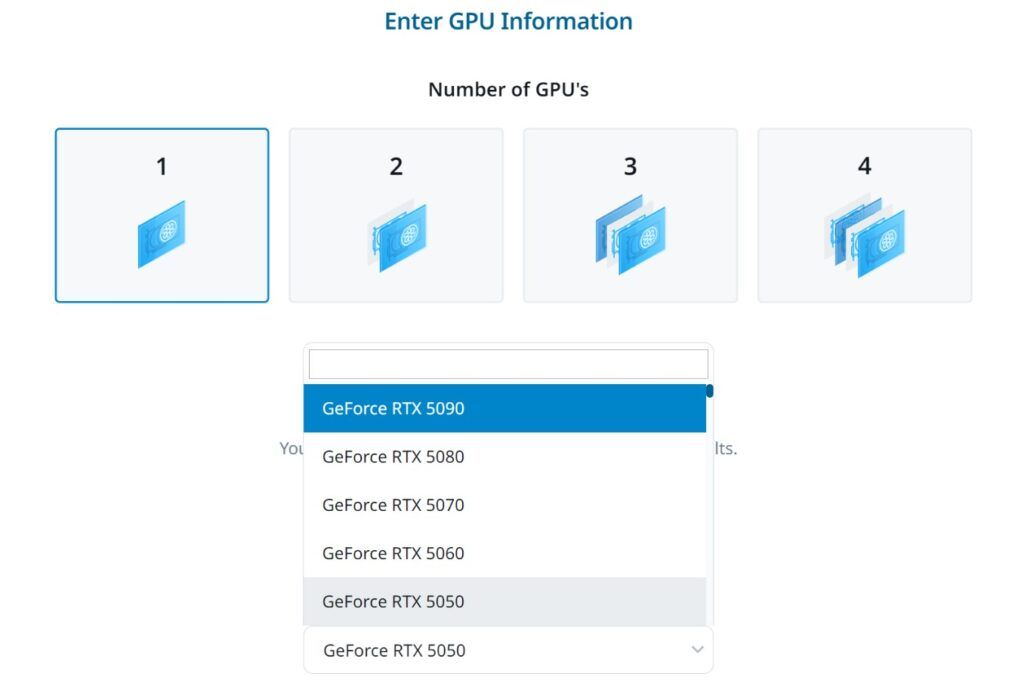
Preliminary TDPs of NVIDIA’s GeForce RTX 50 “Blackwell” Gaming GPUs, including the RTX 5090 and RTX 5080, have been disclosed by Seasonic.
Seasonic Indicates Higher TDPs for NVIDIA’s Upcoming GeForce RTX 50 “Blackwell” Gaming GPU Lineup: RTX 5090 at 500W
In addition to AMD’s Radeon RX 7000 “RDNA 3” refresh models, the Seasonic Wattage Calculator has also listed the NVIDIA GeForce RTX 50 “Blackwell” gaming GPUs. The manufacturer lists five models, including the GeForce RTX 5090, RTX 5080, RTX 5070, RTX 5060, and RTX 5050. It’s important to note that these graphics cards and their associated TDPs are preliminary and should not be considered final specifications.

Starting with the flagship GPUs, the NVIDIA GeForce RTX 5090 is set to replace the RTX 4090 as the next-gen leader. Currently, the NVIDIA GeForce RTX 4090 has a TDP of 450W, and the next-gen model is suggested to go even higher with a 500W TDP, a 50W increase (+11%). NVIDIA is developing new cooling solutions and PCB designs for its Blackwell flagships like the RTX 5090 and RTX 5080. If the company indeed aims for higher power, necessary adjustments will be made in the new Founders Edition designs.

The NVIDIA GeForce RTX 5080 is listed with a TDP of 350W, which is an increase over the 320W TDPs of the GeForce RTX 4080 SUPER and RTX 4080. This marks a 30W increase in TDP (+9.3%). The RTX 4080 SUPER remained unaffected by the core count and memory spec bump over the Non-SUPER variant, but the new Blackwell core might require more power for enhanced performance.
NVIDIA RTX 50 Series TDPs:
- NVIDIA RTX 5090 – 500W TDP (+50W Compared to RTX 4090 / +11%)
- NVIDIA RTX 5080 – 350W TDP (+50W Compared to RTX 4080 / +9.3%)
- NVIDIA RTX 5070 – 220W TDP (+20W Compared to RTX 4070 / +10%)
- NVIDIA RTX 5060 – 170W TDP (+10W Compared to RTX 4060 Ti / +6.2%)
- NVIDIA RTX 5050 – 100W TDP (-15W Compared to RTX 4060 / -13%)
Next up, the NVIDIA GeForce RTX 5070 is listed with a TDP of 220W, the same as the RTX 4070 SUPER but a 20W increase (+10%) over the Non-SUPER variant. The GeForce RTX 5060 is listed at 170W, which is 55W higher than the RTX 4060 and 10W higher than the 4060 Ti. This marks the single largest power increase over the predecessor, +48% over the 4060 and +6.25% versus the 4060 Ti. Lastly, the RTX 5050 is listed at 100W. Since there was no RTX 4050 in the previous lineup, it is speculated to be the RTX 4060 replacement, while the RTX 5060 will replace the RTX 4060 Ti.
Aside from these, it’s noteworthy that Seasonic mentions all NVIDIA GeForce RTX 50 “Blackwell” Gaming GPUs will utilize a 16-pin connector. This is expected to be the new 12V-2×6 design, not the older 12VHPWR design that caused issues with the RTX 4090.
Seasonic is a major PSU manufacturer with connections to various GPU vendors, providing them with early insights into upcoming hardware. However, it’s possible that this data is based on educated guesses by the manufacturer. It’s worth noting that past releases, especially Ada GPUs, showed that TDPs are often higher than actual power consumption. The RTX 4090 rarely exceeds 400W during gaming, despite its 450W TDP.
The NVIDIA GeForce RTX 50 “Blackwell” Gaming GPUs are expected to be introduced later this year, with more information likely to emerge around Q4 2024, as CPU launches will dominate Q3 activities.
NVIDIA GeForce RTX 50 “Blackwell” GPU Configurations:
- GB202: 12 GPCs, 96 TPCs, 192 SMs, 24576 cores, 512-bit GDDR7 – GeForce RTX 5090
- GB203: 7 GPCs, 42 TPCs, 84 SMs, 10752 cores, 256-bit GDDR7 – GeForce RTX 5080
- GB205: 5 GPCs, 25 TPCs, 50 SMs, 6400 cores, 192-bit GDDR7 – GeForce RTX 5070
- GB206: 3 GPCs, 18 TPCs, 36 SMs, 4608 cores, 128-bit GDDR7 – GeForce RTX 5060 Ti
- GB207: 2 GPCs, 10 TPCs, 20 SMs, 2560 cores, 128-bit GDDR6 – GeForce RTX 5060








By Andrej Kovacevic
Updated on 15th July 2024